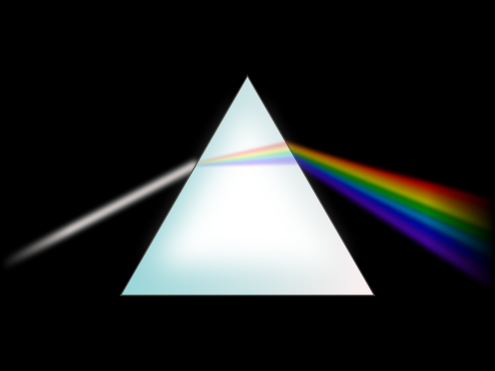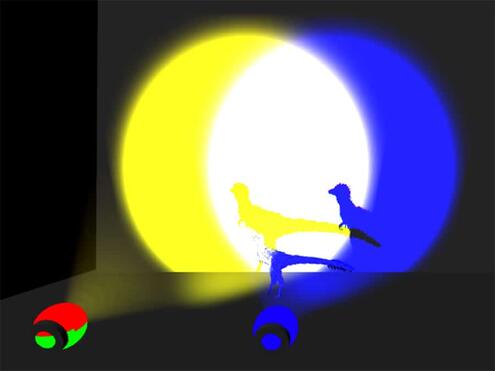
PLAY WITH
COLOR
& LIGHT
PLAY WITH
COLOR
& LIGHT

The great English scientist Sir Isaac Newton (1643-1727) used a prism to separate the colors that make up white light, making each color visible. And combining these same colors makes white light.
What happens when you mix different colors of light? Unlike mixing paint, which will give you a darker color, when you mix all the colors of light, you get white light! It happens all the time. The white light all around us — whether from the Sun or from a regular lightbulb — is a combination of different colored light.
The great English scientist Sir Isaac Newton (1643-1727) used a prism to separate the colors that make up white light, making each color visible. And combining these same colors makes white light.
See for Yourself!
Below are three beams of lights — one red, one green, and one blue. You can move the beams to make them overlap. When all three colors overlap, they blend to make white. See what happens when you mix different colors. What colors do you see in the shadows? Can you make a yellow shadow? How about a blue shadow?
Try this! Make a yellow shadow

- Change the object until you get the small dinosaur.
- Place the blue light directly in front of the dinosaur.
- Overlap the red and green lights and place them over to the side. You will see a yellow dinosaur-shaped shadow.
More to Try
What happens when you block one color?
When you block one of the light beams, you should see a colored shadow. Where did the color come from? If you’ve only blocked one beam, the other two colors still reach your shadow, creating a blended color that may surprise you.
Can you make a purple shadow?
Hint: Try blocking the beams one at a time. Which one makes a purple shadow when it’s blocked?
What happens when you block two colors?
If you block two colors, you will make two shadows. Each shadow is filled in by the other beams. Where they cross, two colors are blocked, so the shadow will be filled in only by the third beam.
Can you make a blue shadow?
Hint: Try blocking the red beam along with one other beam.
What happens when you block three colors?
Each beam of light casts its own shadow, which is filled in by the other colors. Where shadows overlap, two colors are blocked, and only the third is visible. If a shadow blocks all three beams, it will have no color.
The Museum gratefully acknowledges the Richard and Karen LeFrak Exhibition and Education Fund.
Generous support for The Nature of Color has been provided by the Eileen P. Bernard Exhibition Fund.
The Nature of Color is generously supported by Chase Private Client.
This educational resource for The Nature of Color is made possible by the Anna-Maria and Stephen Kellen Foundation.
Image Credits:
Prism-rainbow.svg: Suidroot derivative work: Sceptre, CC BY-SA 3.0, via Wikimedia Commons.




 Biodiversity
Biodiversity
 Brain
Brain
 Genetics
Genetics
 Marine BiOLogy
Marine BiOLogy
 MicrobiOLogy
MicrobiOLogy
 PaleontOLogy
PaleontOLogy
 ZoOLogy
ZoOLogy
 AnthropOLogy
AnthropOLogy
 ArchaeOLogy
ArchaeOLogy
 Astronomy
Astronomy
 Climate Change
Climate Change
 Earth
Earth
 Physics
Physics
 Water
Water
